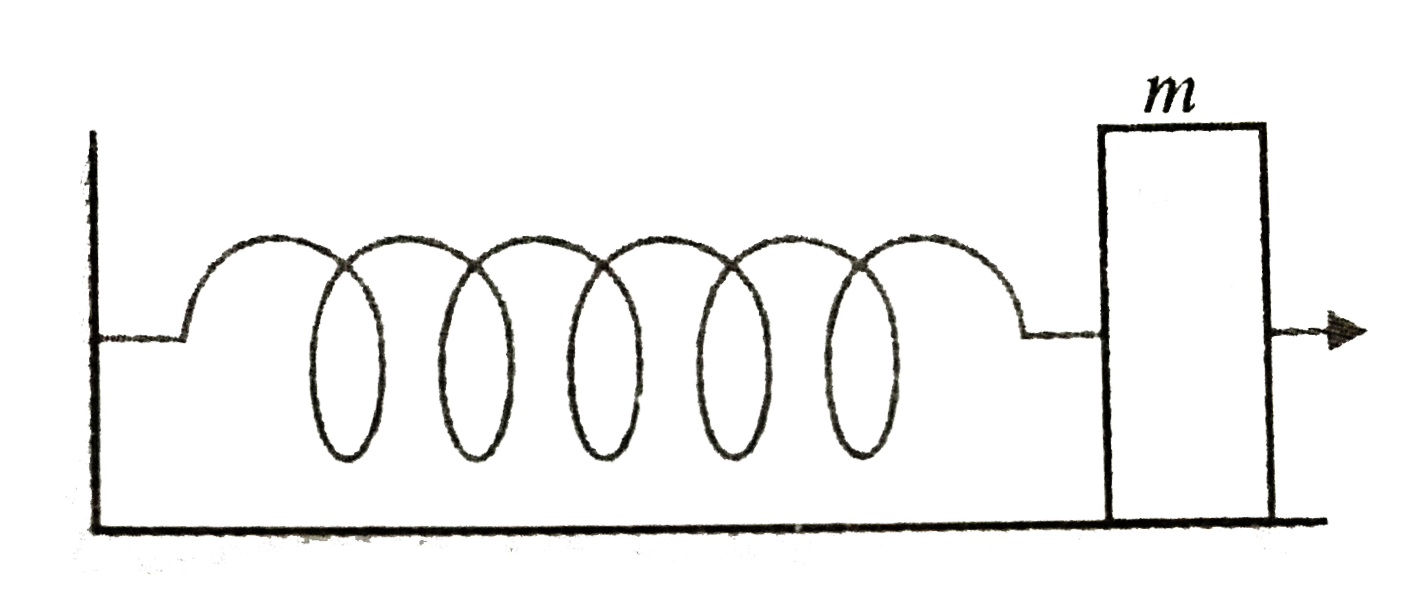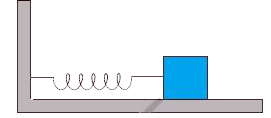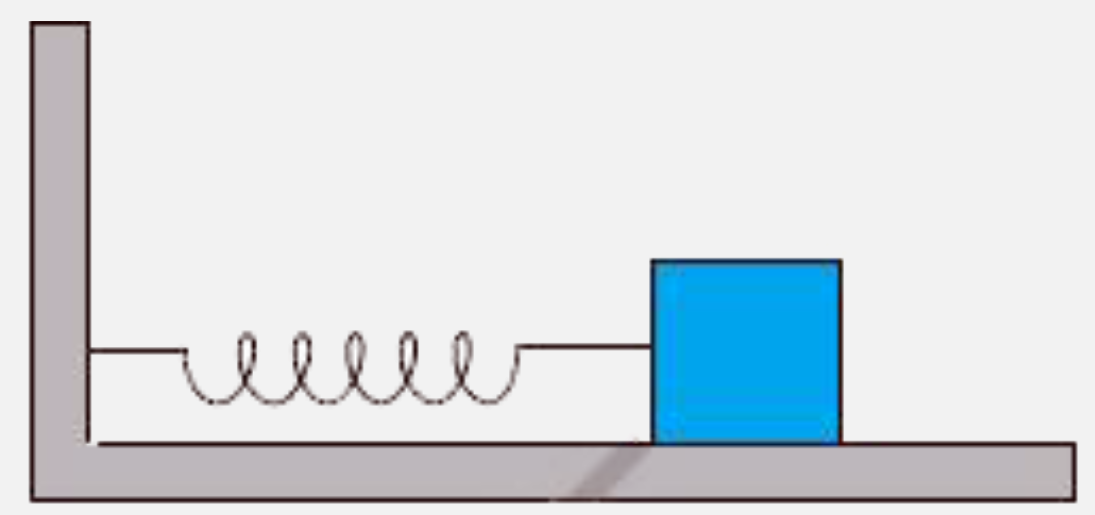A spring of force constant 1200Mm−1 is mounted on a horizontal table as shown in fig. A mass of 3.0 kg is attached to the free end of the spring, pulled side ways to a distance 2.0 cm and released. Determine
a. the frequency of oscillation of the mass.
b. the maximum acceleration of the mass.
c. the maximum speed of the mass.

Here k=120Nm−1mm=3.0kg,A=2.0cm=0.02m
a. Frequency f=1T=12A√km=12×3.14√12003=3.2s−1
b. Acceleration a=ω2y=kmy
Acceletaration will be maximum when y is maximum i.e. y=A
∴ Max acceleration amax=kAm=1200×0.023=8ms−2
c. Max. speed of the mass will be when it is passing through the mean position whcih is given by
Vmax=Aω=A√km=0.02×√12003=0.4ms−1
Topper's Solved these Questions
- OSCILLATIONSBook:AAKASH SERIESChapter:OSCILLATIONSExercise:EXERCISE I
Explore 184 Videos
- OSCILLATIONSBook:AAKASH SERIESChapter:OSCILLATIONSExercise:EXERCISE II
Explore 175 Videos
- OSCILLATIONSBook:AAKASH SERIESChapter:OSCILLATIONSExercise:EXERCISE-3
Explore 49 Videos
- OSCILLATIONBook:AAKASH SERIESChapter:OSCILLATIONExercise:QUESTIONS FOR DESCRIPTIVE ANSWERS
Explore 12 Videos
- PHYSICAL WORLDBook:AAKASH SERIESChapter:PHYSICAL WORLDExercise:VERY SHORT ANSWER TYPE QUESTIONS
Explore 5 Videos
Similar Questions
A praticle moves in a circular path with a uniform speed. Its motion is
View SolutionA particle is subjected to two S H Ms x1=A1sinwt and x2=A2sin(wt+π/4). The resultant S H M will have an amplitude of
View SolutionThe displacement of two particles executing S.H.M are represented by y1=asin(wt+ϕ) and y2=acoswt. The phase difference between the velocities of these particles is
View SolutionThe spring shown in figure is unstretched when a man starts pulling on the cord. The mass of the block is M. If the man exerts a constant force F, find the amplitude and the time period of the motion of the block.

View SolutionWhat is Physics ?
View SolutionA spring of force constant 1200Nm−1 is mounted on a horizontal table as shown in figure. A mass of 3.0kg is attached to the free end of the spring, pulled side ways to a distance of 2.0cm and released. Determing.
(a) the frequency of oscillation of the mass.
(b) the maximum acceleration of the mass.
(c) the maximum speed of the mass.

View Solutionएक स्प्रिंग का बल नियतांक 1200 न्यूटन/ मीटर है । स्प्रिंग के स्वतंत्र सिरे में3.0 किग्रा द्रव्यमान का एक पिंड संलग्न है। पिंड को किसी एक ओर 2 सेमी खींचकर छोड़ दिया जाता है ज्ञात कीजिए -
दोलन आवृत्ति |
View Solutionएक स्प्रिंग का बल नियतांक 1200 न्यूटन मीटर है तथा स्प्रिंग के स्वतंत्र सिरे में3.0 किग्रा द्रव्यमान का एक पिंड संलग्न है। पिंड को किसी एक ओर 2 सेमी खींचकर छोड़ दिया जाता है ज्ञात कीजिए -
अधिकतम त्वरण ,
View Solutionएक स्प्रिंग का बल नियतांक 1200 न्यूटन मीटर है । स्प्रिंग के स्वतंत्र सिरे में3.0 किग्रा द्रव्यमान का एक पिंड संलग्न है। पिंड को किसी एक ओर 2 सेमी खींचकर छोड़ दिया जाता है ज्ञात कीजिए -
अधिकतम चाल।
View SolutionA spring having a spring constant 1200Mn^(-1) is mounted on a horizontal table. A mass of 3 kg is attached to the free end of the spring. The mass is then pulled sideways to a distance of 0.02 m and released. Determine (i) frequency of oscillations (ii) maximum acceleration of the mass and (iii) the maximum speed of the mass.
View SolutionA spring having with a spring constant 1200 N m^(-1) is mounted on a horizontal table as shown in Fig. 14.24. A mass of 3 kg is attached to the free end of the spring. The mass is then pulled sideways to a distance of 2.0 cm and released. Determine (i) the frequency of oscillations, (ii) maximum acceleration of the mass, and (iii) the maximum speed of the mass.
View SolutionA spring having with a spring constant 1200 N m^(-1) is mounted on a horizontal table as shown in Fig. 14.24. A mass of 3 kg is attached to the free end of the spring. The mass is then pulled sideways to a distance of 2.0 cm and released. Determine (i) the frequency of oscillations, (ii) maximum acceleration of the mass, and (iii) the maximum speed of the mass.
View SolutionA spring of force constant 1200Nm−1 is mounted on a horizontal table as shown in figure. A mass of 3.0kg is attached to the free end of the spring, pulled side ways to a distance of 2.0cm and released. Determing.
(a) the frequency of oscillation of the mass.
(b) the maximum acceleration of the mass.
(c) the maximum speed of the mass.

View SolutionA spring having with a spring constant 1200Nm−1 is mounted on a horizontal table as shown in Fig. 14.24. A mass of 3 kg is attached to the free end of the spring. The mass is then pulled sideways to a distance of 2.0 cm and released.

Determine (i) the frequency of oscillations, (ii) maximum acceleration of the mass, and (iii) the maximum speed of the mass.
View SolutionA spring having with a spring constant 1200Nm−1 is mounted on a horizontal table as shown in Fig. 14.24. A mass of 3 kg is attached to the free end of the spring. The mass is then pulled sideways to a distance of 2.0 cm and released.

Determine (i) the frequency of oscillations, (ii) maximum acceleration of the mass, and (iii) the maximum speed of the mass.
View SolutionA spring of force constant 1200 Nm^(-1) is mounted on a horizontal table as shown in Fig. A mass of 3.0 kg is attached to the free end of the spring, pulled side ways to a distance 2.0 cm and released. Determine the frequency of oscillation of the mass.
View Solution

